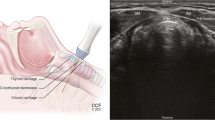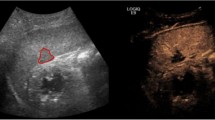Abstract
In cadavers, even Thiel-embalmed cadavers, the arteries (especially the thoracic aorta) are extremely collapsed. This is in marked contrast to the state of the arteries in a living body. Aortic inflation is necessary to improve this unfavorable situation for anatomical observation or dissection. To inflate the aorta, we injected 500 ml of hot liquid agar into the aorta using a 18-Fr catheter inserted into the common femoral artery and subclavian artery. The injected agar then rapidly cools to room temperature and solidifies. As a result, the thoracic aorta remains sufficiently and constantly inflated in the mediastinum. This method is not only easy and inexpensive, but also useful and effective for achieving a life-like anatomy in cadavers used in surgical training for operations involving mediastinal organs, with the exception of the heart and great vessels.


Similar content being viewed by others
References
Thiel W. The preservation of the whole corpse with natural color. Ann Anat. 1992;174:185–95.
Thiel W. Supplement to the conservation of an entire cadaver according to W. Thiel. Ann Anat. 2002;184:267–9.
Aboud E, Al-Mefty O, Yasargil MG. New laboratory model for neurosurgical training that simulates live surgery. J Neurosurg. 2002;97:1367–72.
Aboud ET, Krisht AF, O'Keeffe T, Nader R, Hassan M, Stevens CM, et al. Novel simulation for training trauma surgeons. J Trauma. 2011;71:1484–90.
Carey JN, Minneti M, Leland HA, Demetriades D, Talving P. Perfused fresh cadavers: method for application to surgical simulation. Am J Surg. 2015;210:179–87.
Garrett HE Jr. A human cadaveric circulation model. J Vasc Surg. 2001;33:1128–30.
Minneti M, Baker CJ, Sullivan ME. The development of a novel perfused cadaver model with dynamic vital sign regulation and real-world scenarios to teach surgical skills and error management. J Surg Educ. 2018;75:820–7.
Russin JJ, Mack WJ, Carey JN, Minneti M, Giannotta SL. Simulation of a high-flow extracranial-intracranial bypass using a radial artery graft in a novel fresh tissue model. Neurosurgery. 2012;71:ons315–9 (discussion ons 319–20).
Acknowledgements
The authors thank those who donated their bodies for anatomical research and education.
Author information
Authors and Affiliations
Corresponding author
Ethics declarations
Conflict of interest
The authors declare no conflict of interest in association with the present study.
Additional information
Publisher's Note
Springer Nature remains neutral with regard to jurisdictional claims in published maps and institutional affiliations.
Rights and permissions
About this article
Cite this article
Tokairin, Y., Nakajima, Y., Nagai, K. et al. Aortic inflation with agar injection is a useful method of cadaveric preparation which creates a mediastinal anatomy that better mimics the living body for surgical training. Gen Thorac Cardiovasc Surg 68, 652–654 (2020). https://doi.org/10.1007/s11748-019-01258-5
Received:
Accepted:
Published:
Issue Date:
DOI: https://doi.org/10.1007/s11748-019-01258-5




